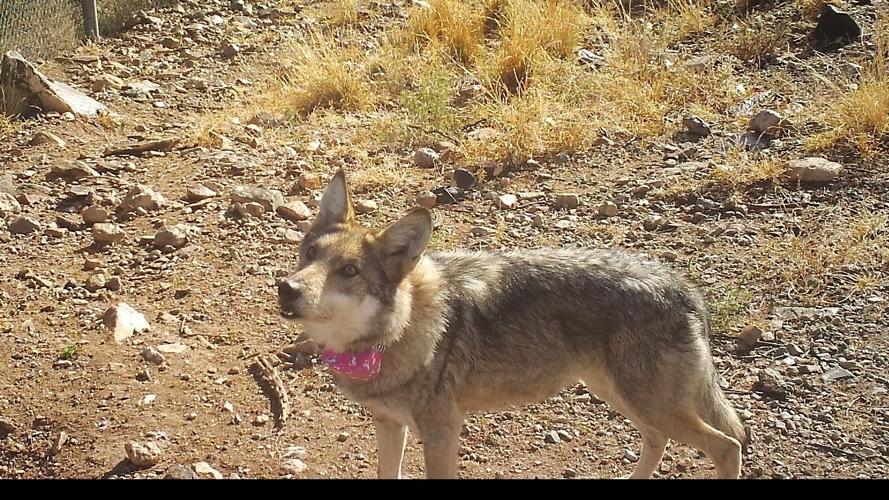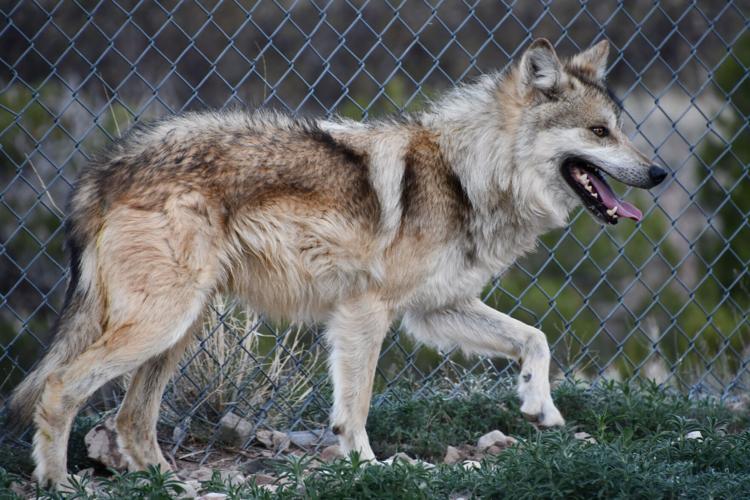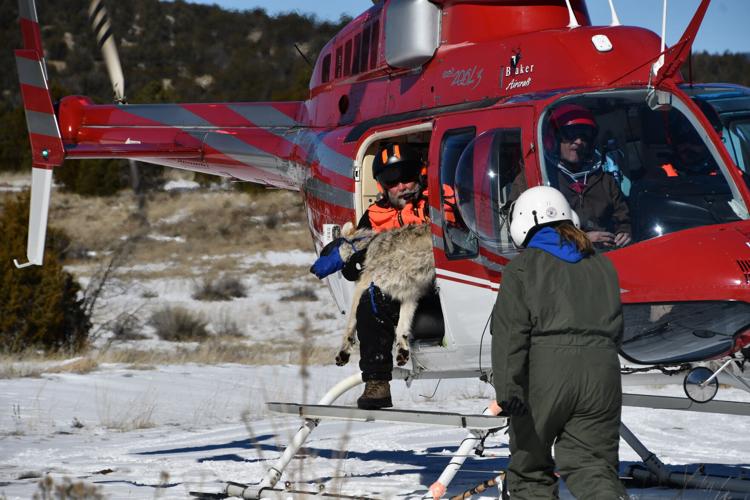Since she was born in the wilds of eastern Arizona in 2018, wolf No. 1828 has been captured three times, lost a mate and survived on both sides of the U.S.-Mexico border.
Now, the endangered Mexican gray wolf — nicknamed Llave, the Spanish word for key — has been set free once again in southeastern Arizona with a new companion by her side, much to the delight of wolf advocates.
On April 29, the U.S. Fish and Wildlife Service translocated the well-traveled wolf into Coronado National Forest Service land east of Douglas.
Joining her there was a young adult male, known to the agency as No. 2774 and to wolf advocates as Wonder.
The pair was released in the Peloncillo Range, a long north-south arc of mountains that straddles the border between Arizona and New Mexico and stretches from northern Mexico almost to the Greenlee County seat of Clifton.
This marks the first time wolves have been turned loose so far south in the U.S., but the location makes perfect sense to Greta Anderson, the Tucson-based deputy director for the nonprofit Western Watersheds Project. That’s where Llave was living when she was captured by wildlife managers in November.
“This was her territory that she dispersed to naturally,” Anderson said. “This was a place that she picked. Now she’s back, and that’s awesome.”

Female Mexican gray wolf No. 1828, nicknamed Llave by wolf advocates, as photographed in captivity on Nov. 18, 2023.
The Mexican subspecies of gray wolf was once common in parts of the southwestern U.S. and Mexico, but by the 1970s it had been hunted, trapped and poisoned to near-extinction.
In 1998, wildlife managers began releasing and monitoring captive-bred wolves across eastern Arizona and western New Mexico as part of a cooperative reintroduction effort among nine federal, state and tribal agencies led by the Fish and Wildlife Service.
As of last year, there were at least 257 wolves roaming the experimental population area designated for the species, which covers a vast swath of the two states. The eighth consecutive year of population growth was seen in 2023, according to estimates from the Mexican Wolf Interagency Field Team.
The Arizona Game and Fish Department assisted the Fish and Wildlife Service with Monday’s translocation, but neither agency publicized it.
Anderson said she learned about the operation from a social media post by the Cochise-Graham Cattle Growers Association.
On April 30, the ranching group advised its members that a wolf pair had been set free east of Douglas and reminded them to report any local wolf sightings to the Cochise County Sheriff’s Office.
Aislinn Maestas, public affairs specialist for the Fish and Wildlife Service, said the site for Monday’s translocation was selected “with the intent to minimize impact on livestock producers.”
Den mother

A male Mexican gray wolf nicknamed Wonder, but known officially as No. 2774, as photographed in captivity. The wild-born wolf was paired with a female named Llave (No. 1828) and translocated to the Peloncillo Mountains in the southeastern corner of Arizona on April 29.
Llave was born into the Maverick Pack, whose traditional territory includes parts of Apache-Sitgreaves National Forest and the Fort Apache Indian Reservation.
Maestas said wolf 1828 was captured for the first time and fitted with a tracking collar in 2018.
Three years later, she was caught again and placed in captivity after straying onto the San Carlos Indian Reservation east of Globe.
“They don’t tolerate wolves on their nation,” Anderson explained.
In February 2022, wildlife officials returned Llave to the wild, this time in Mexico with her partner at the time, male wolf No. 1582.
“The thought was if they were released together, they wouldn’t have a reason to go wandering,” Anderson said.
But the pair had other ideas. After just a few months south of the border, they crossed back into the U.S. to establish their home range in the “bootheel” of southwestern New Mexico.
Anderson said data from Llave’s tracking collar showed she and her partner moved freely between the U.S. and Mexico for much of 2022, then settled into the Peloncillos north of the border for the winter.
Llave’s movements suggested she was denned down with pups the following spring, when her mate turned up dead in New Mexico’s Animas Valley.
“His death was suspicious. It’s under investigation,” Anderson said. “It’s likely that she lost her litter because her mate was killed.”
After that, Llave’s collar continued to ping twice a day as she wandered through the Chiricahuas, past Fort Bowie and across Interstate 10 to reach Mount Graham.
Anderson said the wolf might have been searching for others of her kind or trying to make her way north, back to the part of Arizona where she was born.
She eventually ended up back in the Peloncillos, where wildlife officials captured her again in November because there were no other potential mates for her in that area, Maestas said.
Wonder, or male wolf 2774, was also captured in November at the request of the San Carlos Apache Tribe, after he showed up on the reservation.
He was first collared in New Mexico as a yearling in the spring of 2023.
A fresh start
Wonder and Llave spent the winter bonding at the wolf management facility at Sevilleta National Wildlife Refuge south of Albuquerque.
Maestas said the process of pairing up captive wolves starts with an introduction. The male and female are placed in adjacent pens with a shared fence line so they can see and smell each other and interact in a safe way.

A tranquilized Mexican gray wolf is transported during helicopter capture operations in January 2023.
“We observe their behavior, watching for positive behaviors like play-bowing and tail-wagging,” she said. “Depending on how those interactions go, we then open the doors so they can be in the same enclosure.”
Maestas declined to say where Llave and Wonder went after their release on Monday. For the safety of the animals, the Fish and Wildlife Service does not share real-time tracking data.
Eventually, Maestas said, their general location will be added to a public online map maintained by the Mexican Wolf Interagency Field Team. The pair will show up on that map as the Manada del Arroyo pack, the same pack name Llave had when she and her previous mate were set free in Mexico.
“Restoring these wolves to the wild is definitely worth celebrating,” said Chris Smith, southwest wildlife advocate for WildEarth Guardians, a Santa Fe, New Mexico-based environmental group. “The U.S. Fish and Wildlife Service would do well to release more bonded family packs of endangered lobos into the Southwest to help ease the genetic crisis this species is facing.”
Anderson said she is thrilled to see Llave starting a new chapter after what has already been “a fascinating life history.”
She called it a testament to the species’ resiliency and its millennia-long connection to the sky-island mountain ranges of Arizona and New Mexico.
“This is something to be excited about,” Anderson said. “Wolves belong here.”

A new billboard on Interstate 25 in New Mexico promises a reward for information about illegal wolf killings.
A 2023 video highlights a major milestone for the multiagency effort to reintroduce Mexican gray wolves to Arizona and New Mexico.







